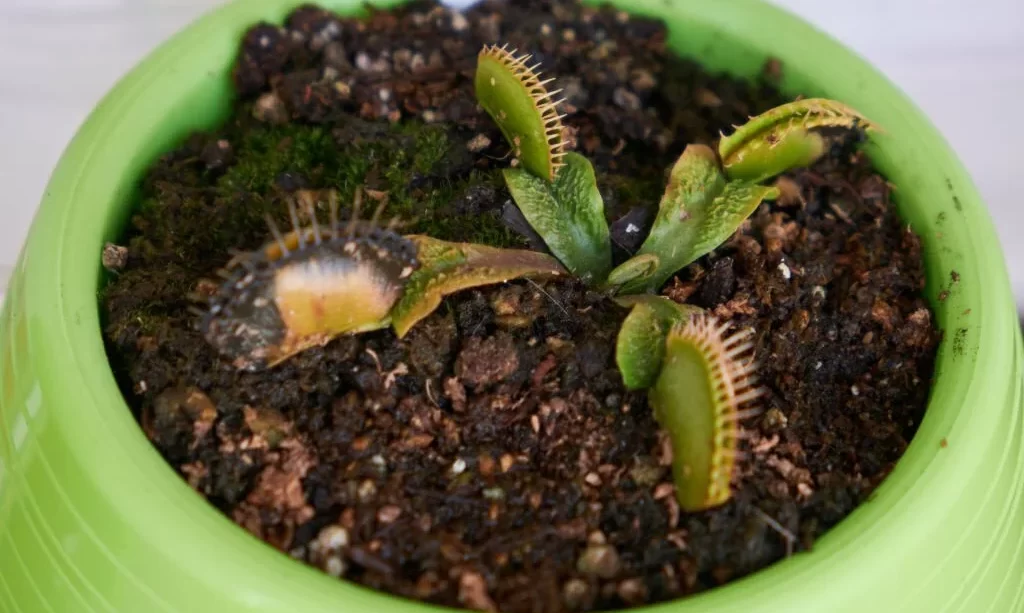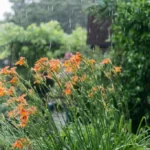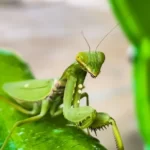Venus Fly Traps (Dionaea muscipula) are captivating and unique carnivorous plants known for their iconic, hinged traps that snap shut when triggered by unsuspecting prey. While these plants are fascinating additions to botanical collections, their care requirements, particularly watering, can be a source of uncertainty for enthusiasts. This article aims to provide comprehensive guidance on how often to water Venus Fly Traps, recognizing the pivotal role that water plays in sustaining these remarkable plants. By understanding their specific watering needs and dispelling common misconceptions, plant enthusiasts can cultivate thriving and healthy Venus Fly Traps in their care.
Venus Fly Trap Watering Needs
Venus Fly Traps, native to the boggy regions of North and South Carolina in the United States, have evolved to thrive in nutrient-poor, acidic soils. In their natural habitat, they receive ample water from rain and nutrient supplementation through captured insects. Understanding this natural environment is crucial for replicating appropriate watering conditions in a cultivated setting.
Water plays a vital role in supporting the overall health of Venus Fly Traps, contributing to nutrient absorption and aiding in the digestion of captured prey. Contrary to popular belief, these plants do not require overly wet conditions; instead, they prefer consistently moist soil. Proper watering is essential for maintaining the delicate balance between hydration and aeration in the soil, ensuring the roots receive adequate moisture without risking root rot—a common pitfall for Venus Fly Trap enthusiasts.
By delving into the inherent watering needs of Venus Fly Traps, plant caregivers can establish a foundation for providing the optimal conditions necessary for the health and vitality of these captivating carnivorous plants.
Factors Influencing Watering Frequency
Several factors influence the watering frequency for Venus Fly Traps, and understanding these variables is key to providing optimal care. One crucial aspect is the type and composition of the soil. Venus Fly Traps thrive in a well-draining, acidic medium, typically a mixture of sphagnum moss and perlite. The composition of the soil directly impacts how quickly it dries out, affecting the plant’s water needs.
Environmental conditions also play a significant role. The humidity level, ambient temperature, and sunlight exposure all contribute to the rate at which the soil retains moisture. Higher temperatures and increased sunlight can accelerate evaporation, necessitating more frequent watering. Conversely, in cooler or more humid conditions, the soil may retain moisture for a more extended period.
The growth stage of the Venus Fly Trap is another factor to consider. During active growth periods, such as spring and early summer, the plant may require more water to support new foliage and traps. Understanding these influencing factors allows plant enthusiasts to tailor their watering routine to the specific needs of their Venus Fly Traps.
Signs of Underwatering and Overwatering
Recognizing the signs of underwatering and overwatering is crucial for maintaining the health of Venus Fly Traps. Underwatering often manifests in visibly wilted or limp traps, with the plant exhibiting an overall lack of vigor. The traps may also close more slowly, and the plant may show signs of stress, such as browning leaf edges.
Conversely, overwatering can lead to waterlogged soil and root rot. Signs of overwatering include yellowing leaves, a foul odor emanating from the soil, and a mushy texture in the roots. Overwatered Venus Fly Traps may also exhibit trap decline, where the traps blacken and die prematurely. Careful observation of these visual indicators is crucial for adjusting watering practices promptly and preventing long-term damage to the plant.
By being attuned to the nuanced signs of underwatering and overwatering, plant caregivers can strike the right balance, ensuring that their Venus Fly Traps receive the appropriate amount of moisture for optimal health and vitality.
Establishing a Watering Routine
Establishing a consistent watering routine is fundamental to the well-being of Venus Fly Traps. While there is no one-size-fits-all schedule due to the variability in environmental conditions and individual plant needs, certain guidelines can assist in creating an effective routine. Generally, Venus Fly Traps prefer to be kept consistently moist, not overly wet. The soil should never be allowed to dry out completely between waterings.
A helpful approach is the “tray method”. This involves placing the plant’s pot in a tray filled with distilled or rainwater. The water level in the tray should be maintained just below the pot’s surface, allowing the soil to wick up moisture as needed. This method ensures a steady supply of water without risk of waterlogged soil, which can be detrimental to Venus Fly Traps.
The quality of water is equally important. Venus Fly Traps are sensitive to minerals present in tap water, so it’s advisable to use distilled or rainwater to prevent the accumulation of harmful substances in the soil. By establishing a consistent watering routine and paying attention to the quality of water used, caregivers can provide the ideal moisture conditions for their Venus Fly Traps.
Adjusting Watering Frequency
Adapting the watering frequency of Venus Fly Traps is a dynamic process that requires careful observation and responsiveness to the plant’s changing needs. Seasonal variations often influence the plant’s growth patterns and water requirements. During the active growing season, typically spring and early summer, Venus Fly Traps may need more frequent watering to support their vigorous growth.
Environmental changes, such as shifts in temperature or humidity, also warrant adjustments to the watering routine. In warmer and drier conditions, the soil may dry out more quickly, necessitating increased watering frequency. Conversely, during cooler or more humid periods, the soil may retain moisture for a more extended period, requiring less frequent watering.
Monitoring the plant’s response to adjustments in watering frequency is crucial. If signs of stress, such as wilting or browning, persist, it may be an indication that the watering routine needs further refinement. By remaining attentive to these factors, caregivers can ensure that their Venus Fly Traps receive the precise amount of water needed to thrive throughout the changing seasons.
Conclusion
In the quest to nurture healthy and thriving Venus Fly Traps, mastering the art of watering is paramount. By understanding the unique needs of these captivating carnivorous plants and tailoring watering routines to their specific requirements, caregivers can foster an environment conducive to growth and vitality.
Through careful observation of factors influencing watering frequency, recognition of signs of underwatering and overwatering, and the establishment of a consistent watering routine, plant enthusiasts empower themselves to provide optimal care for their Venus Fly Traps. The flexibility to adjust watering frequency based on seasonal and environmental changes ensures that these remarkable plants can flourish year-round.
As you embark on the journey of caring for Venus Fly Traps, let the principles outlined in this guide be your compass. By cultivating a deeper understanding of their watering needs, you not only enhance the well-being of your plants but also unlock the full allure of these intriguing botanical wonders. Cheers to a flourishing and vibrant community of Venus Fly Traps in your care!



